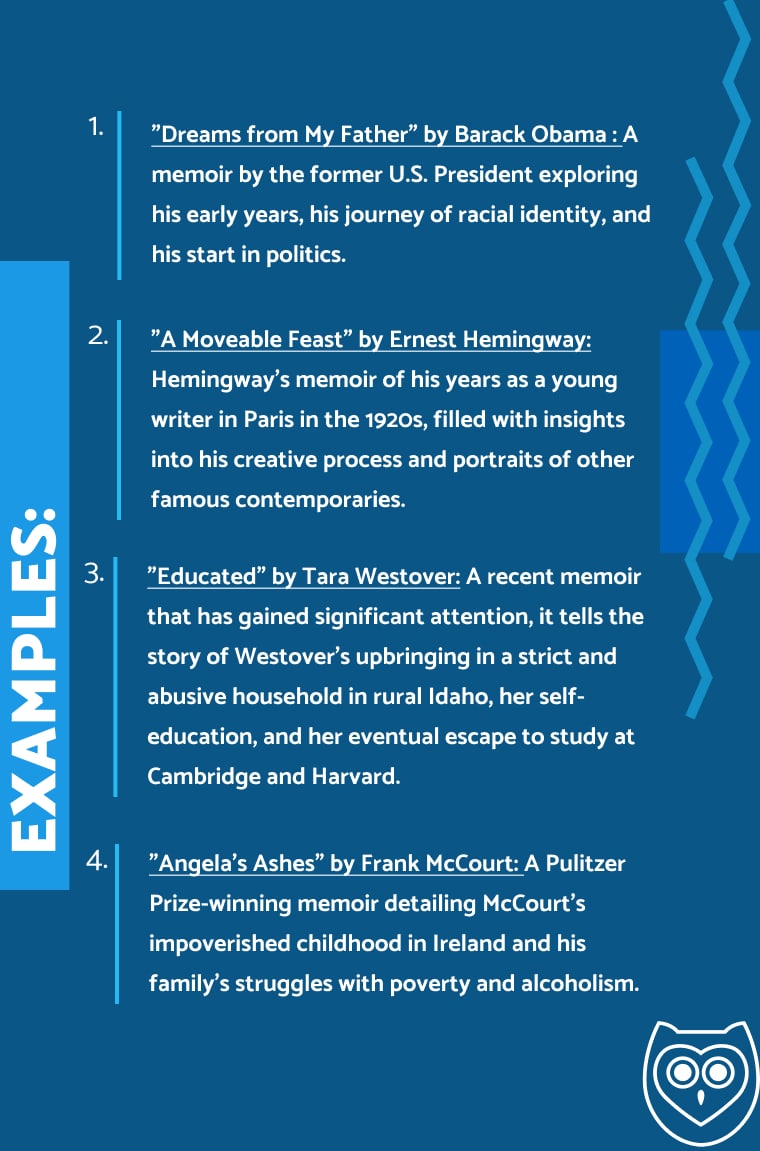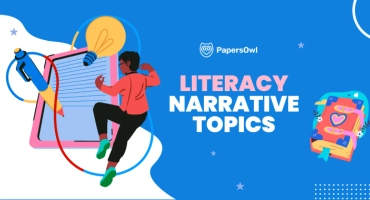How to Write an Autobiography Essay?
Table of contents
- 1 What Is an Autobiography?
- 2 Key Features of an Autobiography Essay:
- 3 Autobiography Types
- 4 Composing an Autobiography About Myself Essay Outline
- 5 How to Structure an Autobiography Essay?
- 6 How to Title an Autobiography Essay?
- 7 Tips on Writing Autobiographical Essay
- 8 Autobiography Example You Want to Read
- 9 Bottom Line
When you start your autobiography writing, it is like a teleport to your past. In fact, it’s a chance to explore your feelings, experiences, and thoughts. You are able to transform your life into an engaging story that appeals to readers. The task could feel overwhelming, though. Your level of writing experience or familiarity with a personal narrative is not enough to craft a perfect essay. If the task seems too personal or difficult to structure effectively, you can choose to pay for essay writing assistance focused on personal narratives. But, with the correct strategy, writing your life’s story may be rewarding.
In this article, you will find answers:
- What types of autobiography essays exist;
- How to write an autobiography;
- What is the basic essay about yourself?
Together, let’s set out on this life-changing adventure to discover the craft of autobiographical storytelling.
What Is an Autobiography?
An autobiography essay is an introspective narrative that examines a person’s life story through noteworthy occasions, feelings, and personal revelations. It is a thorough analysis of experiences that connects noteworthy incidents to broader themes and lessons, rather than merely a list of life events in chronological order.
The tone is casual, giving the story a conversational vibe that helps readers relate to and find the story interesting. Writing an autobiography enables readers to relate to your journey on a personal level. Autobiographies are there to inspire others. It is an amazing opportunity to share life lessons gained from your own path, preserve family history for future generations, or simply for self-reflection.
This kind of essay focuses on significant events, connections, and accomplishments in your life. It must be a perfect balance between narrative and reflection. Also, remember the line between storytelling and introspection!
Key Features of an Autobiography Essay:
- Definition and Purpose:
A narrative about one’s life that considers experiences and insights is called an autobiography. It can be applied to self-reflection, academic assignments, and sharing with a wider audience.
- Audience Consideration:
Tailor your essay for your intended audience — be it academic, personal, or professional. Ensure your tone and content align with their expectations and interests.
- Tone and Style:
Adopt a tone: formal, informal, or conversational. Make it consistent with your essay’s purpose and audience. For instance, an informal style often engages readers through a relatable and personal approach.
- Reflective Writing:
Go beyond recounting events; use analogy and introspection to explore the significance of moments and their role in shaping your identity and worldview.
- Engaging Dialogue:
Incorporate dialogue to bring stories to life, revealing interactions with family members or others and adding authenticity to your narrative.
Autobiography Types
Autobiographical writing offers a glimpse into the rich tapestry of human experience! It provides diverse ways to explore personal journeys.
From chronicling entire life stories to focusing on transformative moments, each type of autobiography brings a unique perspective to self-narration! Let’s see what types of autobiography you can enjoy writing!
Traditional Autobiography
A traditional autobiography chronologically narrates a person’s entire life from birth to the present. It captures all the significant events that have shaped the author’s journey: family background, education, career, and key moments.
Writers often start with a compelling topic sentence to hook a reader, providing a panoramic view of a well-lived life. This type of autobiography gives future readers, including future generations, a comprehensive understanding of the author’s life while preserving their story for posterity.
Memoir
A memoir focuses on specific periods or themes in someone’s life. Memoir offers a fresh perspective on particular significant moments. This type dives deeply into personal experiences, emotions, and insights.
Memoir allows authors to reflect on transformative events or lessons learned. Here readers can find relatable autobiography examples of resilience or growth. Aspiring writers often start this process by identifying a key moment or theme to anchor their story and build it from there.
Spiritual Autobiography
This type of autobiography explores the author’s quest for meaning. It is called spiritual, because the narrative goes via religious faith or personal enlightenment. It often recounts significant moments of transformation, like a spiritual awakening.
While deeply personal, these works often resonate universally, offering lessons for future generations. Writers use vivid descriptions to capture moments of clarity or struggle, creating an emotional connection with readers.
Confessional Autobiography
Confessional autobiographies focus on introspection and self-revelation, being a platform for reflection and redemption. They detail the author’s struggles, failures, and eventual triumphs.
Such works are therapeutic for the writer. Moreover, they are inspiring for readers. Incorporating comic relief or moments of levity can enhance engagement while the process becomes a growth journey. Writers should strive for honesty and authenticity! That way their autobiography will resonate with audiences.
Intellectual Autobiography
Intellectual autobiographies explore the development of an author’s beliefs and worldview. They trace the evolution of ideas, often using writing techniques like analogies to illustrate intellectual growth.
Authors in this category hook a reader with reflections on the events or influences that shaped their intellectual journey. The audience can gain insight into the author’s worldview.
Therapeutic Autobiography
Therapeutic autobiography is a healing process. Authors recount traumatic events to process their experiences and find solace in storytelling.
Perhaps not all works in this category are meant for publication. Still, writing helps authors reclaim their narratives and make sense of their past. Including a professional editor in later drafts can refine the story for broader audiences, ensuring the tone remains both personal and impactful.
Fictionalized Autobiography
Combine the aspects of fiction with real-life events. Thus, it will end up with a particularly wonderful type of narrative ━ fictionalized autobiography.
Authors use their personal experiences to craft innovative yet timely fiction. This genre offers the freedom to explore sensitive topics or reframe challenging events while maintaining the essence of the author’s own story. Here, you should balance reality with fiction; these works invite readers to engage with the author’s life from a new angle.
Overall, you can recount an entire manuscript of experiences or focus on a single significant moment. Each type of autobiography allows writers to reflect on their own life.
Keep in mind that the objective of writing an autobiography is to convey your own voice! Still, you have to establish a connection with the reader. To make your work memorable and compelling, start with a well-defined thesis statement, set a reasonable writing schedule, and then polish it!
Composing an Autobiography About Myself Essay Outline
An engaging and well-structured essay outline is essential for bringing clarity and focus to your autobiographical essay. Think of it as a roadmap that guides you through the personal journey you want to share while ensuring your narrative flows naturally and captivates readers. Whether writing about pivotal moments or exploring recurring themes, an outline helps you bring your life story to life.
What Structuring Approach to Choose?
The most important rule when crafting an autobiography introduction or outlining your essay is selecting the right structure. Many students begin with a chronological format, tracing their whole life step-by-step — from early childhood and close family members to significant achievements and lessons learned. This approach provides a clear and organized way to cover someone’s life from start to finish.
Alternatively, a thematic structure groups experiences by recurring themes or pivotal moments. This can include family relationships, personal growth, or challenges faced in daily life. It’s a great way to reflect on the deeper meaning of your experiences and highlight lessons learned.
You can opt for a narrative style, weaving personal experiences into a good story for a more creative touch. This structure prioritizes storytelling, creating an emotional connection with your audience. But let’s dive deep into each approach:
Thematic Order
Writing an autobiography around central themes or subjects rather than time is the simplest way to create one. For example, if you’ve had a life-long passion for music, you could structure your story around music’s role at different stages of your life. Consequently, this approach allows you to delve deeply into how specific themes have influenced your development and worldview. If you need some help with the beginning, find hook examples.
Reverse Chronological Order
If you want to make your essay more engaging, you can use this method. Accordingly, write an autobiography starting from the present and working backward. It can be intriguing as it starts with who you are now and gradually reveals how you got there. For instance, you could begin with your current career achievements and then trace back to your education and early influences. Thus, this method can create suspense and a sense of discovery for the reader.
Flashback or Non-Linear Narrative
This method will help you to create a nonstandard essay. For example, when you write an essay about yourself, begin with a significant event and then use flashbacks to provide context and background. It can create a dramatic effect and draw readers in by immediately immersing them in a pivotal moment. After the initial event, you can jump around in time to slowly unravel the story and its implications.
Circular Narrative
Another way to make an engaging essay is by using a circular narrative approach when you plan your essay. For example, students who start and end with the same scene or theme create a circular journey. Thus, this technique can emphasize personal growth or resolving crucial life challenges. For instance, you might start with a scene of you running in a marathon, then recount how you became a runner, and conclude with the same marathon scene, now imbued with deeper meaning. Besides, you can find more autobiography examples for students on the Internet.
Epistolary Format
You may think that this method is only suitable for fiction books. However, it works just as well with autobiographical student essays. For this purpose, try to write your life story through letters, diary entries, or emails. It can provide a personal and intimate feel, and the chronological order can be varied to convey your story best. If you need help, you can always order essay online.
How to Structure an Autobiography Essay?
If you’ve ever searched online for “autobiography of myself as a student,” you’ve probably noticed that answers vary. This is because every person’s life is unique, and how we tell our life story depends on our personal experiences and writing style. However, some structural elements are universal and widely used in creating a compelling essay that covers your life or focuses on specific moments.
Here, the concept is the same as that of the outline: think of your essay as a trip. At the beginning, introduce readers to your world and set the tone for what’s to come. Every section should connect seamlessly, from your early age and family members to academic milestones and personal growth, creating a narrative that flows naturally.
Body: The “autobiography about yourself” format is simple and similar to any other type of essay. There are no strict limitations or requirements, but certain considerations should be considered.
Each body paragraph should focus on one event or story, maintaining a clear and well-structured path through the paper. Moreover, providing details and writing with clarity is essential, as readers need background information, context, and character relationships to engage fully.
Although not strictly chronological, the essay should have a logical structure, allowing retrospections and flashbacks to flow smoothly. To preserve clarity and consistency, paragraph transitions should be smooth.
Introduction: This is your opportunity to create a memorable first impression. An interesting introduction establishes the thesis that connects your personal experience and sets the tone for the rest of the essay. To start writing, consider sharing an intriguing anecdote, a vivid memory, or even an unexpected fact about yourself that hooks readers immediately.
For example, in many autobiography examples, authors share their own lives with readers. Reflect on your mental health, a defining challenge, or a cherished memory to craft a resonant introduction.
This section is also a great place to hint at the overarching journey you’ll explore, whether overcoming writer’s block, finding a purpose, or reflecting on influences in your life. As you draft this section, remember that the best introductions don’t just inform — they captivate, making readers eager to turn the page.
Body Paragraphs: The body paragraphs are where your story truly unfolds. This is your opportunity to develop your narrative with vivid descriptions, thoughtfully chosen details, and moments highlighting your reflective process. Each paragraph should explore a distinct theme, event, or aspect of your life while contributing to the broader narrative arc.
For instance, one paragraph might delve into your early age and family member dynamics, setting the stage for future growth. Another might explore a personal experience that shaped your character or a mental health journey that added depth to your perspective.
Transitions: Transition is the glue that holds your story together. This little sentence leads readers from one part of your life story to the next. A well-placed transition can also heighten the emotional impact. It prepares readers for a significant revelation or change. Phrases like “From those early days to…” or “What followed was a journey that…” subtly shifts the narrative while maintaining engagement.
Autobiography Conclusion: Summarize the main autobiography ideas presented in the essay. It is a perfect time to offer insights or reflections on the author’s experiences. It should be concise and impactful. Leave a lasting impression on your reader!
These components are typical of autobiographical writing. The order and emphasis may vary depending on the author’s preferences and storytelling approach.
After all, the goal is to create a cohesive autobiography narrative. It must engage readers and offer insight into the author’s life journey.
Important note: after writing, you must revise and polish the essay. Also, don’t forget about punctuation rules.
How to Title an Autobiography Essay?
People do not usually read descriptions of works. They decide whether to read them based on the first thing they see — the cover of an autobiography, meaning the title.
The perfect title for your essay might seem like a small step, but it’s one of the most crucial decisions! Maybe it shouldn’t be defined in the first draft. On the contrary, you can find your perfect title at the end of the writing process.
The title must grab attention, hint at your story’s essence, and leave a lasting impression. Even when they say “do not judge by the cover”, everyone will judge by the cover. And by the title. So, remember, it serves as the first glimpse into your narrative, sparking curiosity and inviting readers. Make them want to explore your vivid details and personal experiences.
In the world of autobiographies, where storytelling varies widely in genre and focus, the title should align with the tone and content of your essay. For example, most autobiographies balance creativity and clarity, intriguing the readers and reflecting the core themes of the work. Your title should feel authentic, like a window into your story, whether it’s a dramatic turning point, a heartfelt moment, or a simple yet profound life lesson.
Consider it part of your engaging introduction when deciding how to title an autobiography. A good title sets expectations for what’s to come. It might echo the emotions within your story, highlight a key theme, or tease an unforgettable moment. If you’re working on a first draft, jot down potential titles as inspiration strikes. As your narrative takes shape, revisit these ideas and refine them.
The key points to consider when titling an autobiography are:
- Keeping the title short and precise.
- Make it as engaging as possible.
- Don’t include every keyword you chose in this part.
Some good title examples are:
- “A Leap of Faith: My Journey Beyond the Comfort Zone”
- “Lessons from the Bench: My First Basketball Season”
- “Breaking Free: A Reflection on My College Years
Tips on Writing Autobiographical Essay
Careful thought and deft narrative are necessary for an engaging essay. Next pointers will assist you in navigating the process and crafting an engaging story:
- Identifying Key Life Events
Start writing after identifying key events or periods that have shaped who you are today. These could be moments of triumph, struggle, growth, or transformation. For this purpose, choose events that are significant to your personal development and contribute to the overarching narrative of your story.
- Theme and Narrative Arc
Find a central theme or narrative arc that ties your story together. Read an autobiography example in the same genre or a few to determine if it is really what you want.
It could be a quest for self-awareness, fortitude in the face of difficulty, or the pursuit of a passion that lasts a lifetime. A distinct theme will therefore aid in directing your narrative and provide your essay with substance and consistency.
- Balancing Facts and Reflections
Connect storytelling and personal reflections. The factual details and descriptions are important! Together with them, infuse your narrative with insights and reflections that add depth and meaning to your experiences.
As a rule, use storytelling techniques to bring your story to life: vivid imagery, sensory details, and emotional resonance.
- Enhancing Your Essay With Dialogues
Consider incorporating dialogue into your narrative to add authenticity and depth. Without a doubt, dialogues may provide details about relationships and produce intimate or tense moments. To increase the essay’s overall impact, use it wisely and sparingly.
- Connecting to the Reader
The easiest way to make your story relatable and engaging is to connect with the reader personally. Share universal truths, emotions, and experiences. Find the point that resonates with a broader audience. Use descriptive language, vivid anecdotes, and heartfelt reflections! Draw readers into your world and make them feel invested in your journey!
- Honesty and Vulnerability
Be honest. Always. Especially in your narrative. Openly share your triumphs and struggles. Vulnerability is not a weakness (unless you do not want it to be). You can embrace it as a strength. and show humility in recounting your experiences. Authenticity increases readers’ empathy and sense of connection!
Autobiography Example You Want to Read
Reading other autobiographies can provide valuable insights into various narrative techniques, styles, and content choices. We strongly recommend exploring how different authors have structured their life stories. Even one same-genre autobiography example or a completely different book deal can gain inspiration for your autobiography.
For instance, “The Diary of a Young Girl” by Anne Frank is a poignant perspective through diary entries. Also “Long Walk to Freedom” by Nelson Mandela acts as a thorough examination of personal development and political conflicts.
Notable examples of autobiographies:

Bottom Line
When writing your autobiography, you must consider the most important lessons. Therefore, embracing authenticity, picking important life events, and combining them into a coherent story is crucial. Finding a main subject or narrative arc, striking a balance between facts and reflections, and establishing a personal connection with readers enhances the appeal and relatability of your work. Additionally, honesty and vulnerability are your allies in engaging readers and leaving a lasting impact.
Therefore, wrap up your autobiography and start your narrative path of self-discovery. Remember, your college autobiographical essays can motivate and connect with others!
Still need assistance with the essay? No worries! Don’t hesitate to use a professional essay service to make your writing journey unforgettable.







